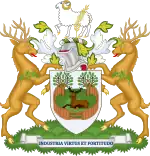Derby City Council | |
|---|---|
 | |
 | |
| Type | |
| Type | |
| Leadership | |
Paul Simpson since January 2020[2] | |
| Structure | |
| Seats | 51 councillors |
 | |
Political groups |
|
| Elections | |
| First past the post | |
Last election | 4 May 2023 |
Next election | 6 May 2027 |
| Motto | |
| Industria, Virtus, et Fortitudo Translation: Diligence, Courage, Strength | |
| Meeting place | |
.jpg.webp) | |
| Council House, Corporation Street, Derby, DE1 2FS | |
| Website | |
| www | |
Derby City Council is the local authority for Derby, a unitary authority with city status in the East Midlands region of England.
As a unitary authority, Derby City Council is responsible for all services within its boundary and is therefore distinct from the two-tier system of local government that exists in the surrounding county of Derbyshire. Outside the city, responsibility is shared between Derbyshire County Council and various district or borough councils.
History
The town of Derby had been an ancient borough, with borough charters dating back to 1154.[3] It was reformed to become a municipal borough in 1836 under the Municipal Corporations Act 1835, governed by a corporate body called "the mayor, aldermen and burgesses of the borough of Derby", generally known as the corporation or town council. When elected county councils were established in 1889 under the Local Government Act 1888, Derby was considered large enough to provide its own county-level services and so it was made a county borough, independent from the surrounding Derbyshire County Council.[4]
In 1974 Derby was reconstituted as a non-metropolitan district under the Local Government Act 1972; it kept the same boundaries but became a lower-tier district council with Derbyshire County Council providing county-level services to the town for the first time.[5] Derby retained its borough status, allowing the chair of the council to take the title of mayor, continuing Derby's series of mayors dating back to 1638.[6] The borough of Derby was awarded city status on 7 June 1977, allowing the council to change its name to Derby City Council.[7]
Derby became a unitary authority on 1 April 1997, regaining its independence from Derbyshire County Council.[8] The city remains party of the ceremonial county of Derbyshire for the purposes of lieutenancy.[9]
Governance
Derby City Council provides all local government services in the area. As a unitary authority it provides both county-level and district-level services. There are no civil parishes in Derby, which is an unparished area.[10]
Political control
The council has been under no overall control since 2018. The council has been run by a Labour minority administration since the 2023 election.
Political control of the council since the 1974 reforms took effect has been as follows:[11][12][13]
Non-metropolitan district
| Party in control | Years | |
|---|---|---|
| Labour | 1974–1976 | |
| Conservative | 1976–1979 | |
| Labour | 1979–1988 | |
| Conservative | 1988–1991 | |
| No overall control | 1991–1994 | |
| Labour | 1994–1997 | |
Unitary authority
| Party in control | Years | |
|---|---|---|
| Labour | 1997–2003 | |
| No overall control | 2003–2005 | |
| Labour | 2005–2006 | |
| No overall control | 2006–2012 | |
| Labour | 2012–2018 | |
| No overall control | 2018–present | |
Leadership
The role of Mayor of Derby is largely ceremonial. Political leadership is instead provided by the leader of the council. The leaders since 2002 have been:[14]
| Councillor | Party | From | To | |
|---|---|---|---|---|
| Chris Williamson | Labour | pre-2002 | 21 May 2003 | |
| Maurice Burgess[15] | Liberal Democrats | 21 May 2003 | 20 Jul 2005 | |
| Chris Williamson | Labour | 20 Jul 2005 | 21 May 2008 | |
| Hilary Jones | Liberal Democrats | 21 May 2008 | 26 May 2010 | |
| Harvey Jennings | Conservative | 26 May 2010 | 25 May 2011 | |
| Philip Hickson | Conservative | 25 May 2011 | 23 May 2012 | |
| Paul Bayliss | Labour | 23 May 2012 | 11 Jun 2014 | |
| Ranjit Banwait | Labour | 11 Jun 2014 | 6 May 2018 | |
| Chris Poulter | Conservative | 23 May 2018 | 24 May 2023 | |
| Baggy Shanker | Labour | 24 May 2023 | ||
Composition
Following the 2023 election, the composition of the council was:[16]
| Party | Councillors | |
|---|---|---|
| Labour | 23 | |
| Conservative | 15 | |
| Reform UK | 6 | |
| Liberal Democrats | 4 | |
| Independent | 3 | |
| Total | 51 | |
The next election is due in 2027.
Premises
The council is based at the Council House on Corporation Street, which was purpose-built for the council. Construction began in 1938 but was interrupted by the Second World War, with the building eventually being completed in 1949.[17]
Elections
Since the last boundary changes in 2023 the council has comprised 51 councillors, representing 18 wards, with each ward electing two or three councillors. Elections are held every four years.[18]
Arms
|
Notes
- ↑ Reform Derby is an independently registered party serving as a local affiliate of Reform UK
References
- ↑ "Derby City Council elections 2023".
- ↑ Hawley, Zena (31 March 2020). "New council chief executive says leading Derby is 'surreal'". Derbyshire Live. Retrieved 28 July 2023.
- ↑ Lambert, Tim. "A History of Derby". Local Histories. Retrieved 28 July 2023.
- ↑ "Derby Municipal Borough / County Borough". A Vision of Britain through Time. GB Historical GIS / University of Portsmouth. Retrieved 28 July 2023.
- ↑ "The English Non-metropolitan Districts (Definition) Order 1972", legislation.gov.uk, The National Archives, SI 1972/2039, retrieved 31 May 2023
- ↑ "District Councils and Boroughs". Parliamentary Debates (Hansard). 28 March 1974. Retrieved 4 December 2021.
- ↑ "No. 47246". The London Gazette. 14 June 1977. p. 7656.
- ↑ "The Derbyshire (City of Derby)(Structural Change) Order 1995", legislation.gov.uk, The National Archives, SI 1995/1773, retrieved 28 July 2023
- ↑ "Lieutenancies Act 1997", legislation.gov.uk, The National Archives, 1997 c. 23, retrieved 28 July 2023
- ↑ "Election Maps". Ordnance Survey. Retrieved 28 July 2023.
- ↑ "Compositions calculator". The Elections Centre. Retrieved 26 May 2023.
- ↑ "Derby". BBC News Online. 19 April 2008. Retrieved 26 September 2009.
- ↑ "Labour wins city council control". BBC News Online. 15 July 2005. Retrieved 26 September 2009.
- ↑ "Council minutes". Derby City Council. Retrieved 21 August 2022.
- ↑ "Ex-Derby council boss jailed for child sex attack". BBC News. 12 August 2011. Retrieved 21 August 2022.
- ↑ "Local elections 2023: live council results for England". The Guardian.
- ↑ "Looking back on the many buildings Derby's councils have called home". Derby Telegraph. 21 September 2018. Retrieved 3 July 2020.
- ↑ "The Derby (Electoral Changes) Order 2023", legislation.gov.uk, The National Archives, SI 2023/201, retrieved 28 July 2023
- ↑ "East Midlands Region". Civic Heraldry of England. Retrieved 5 March 2021.
